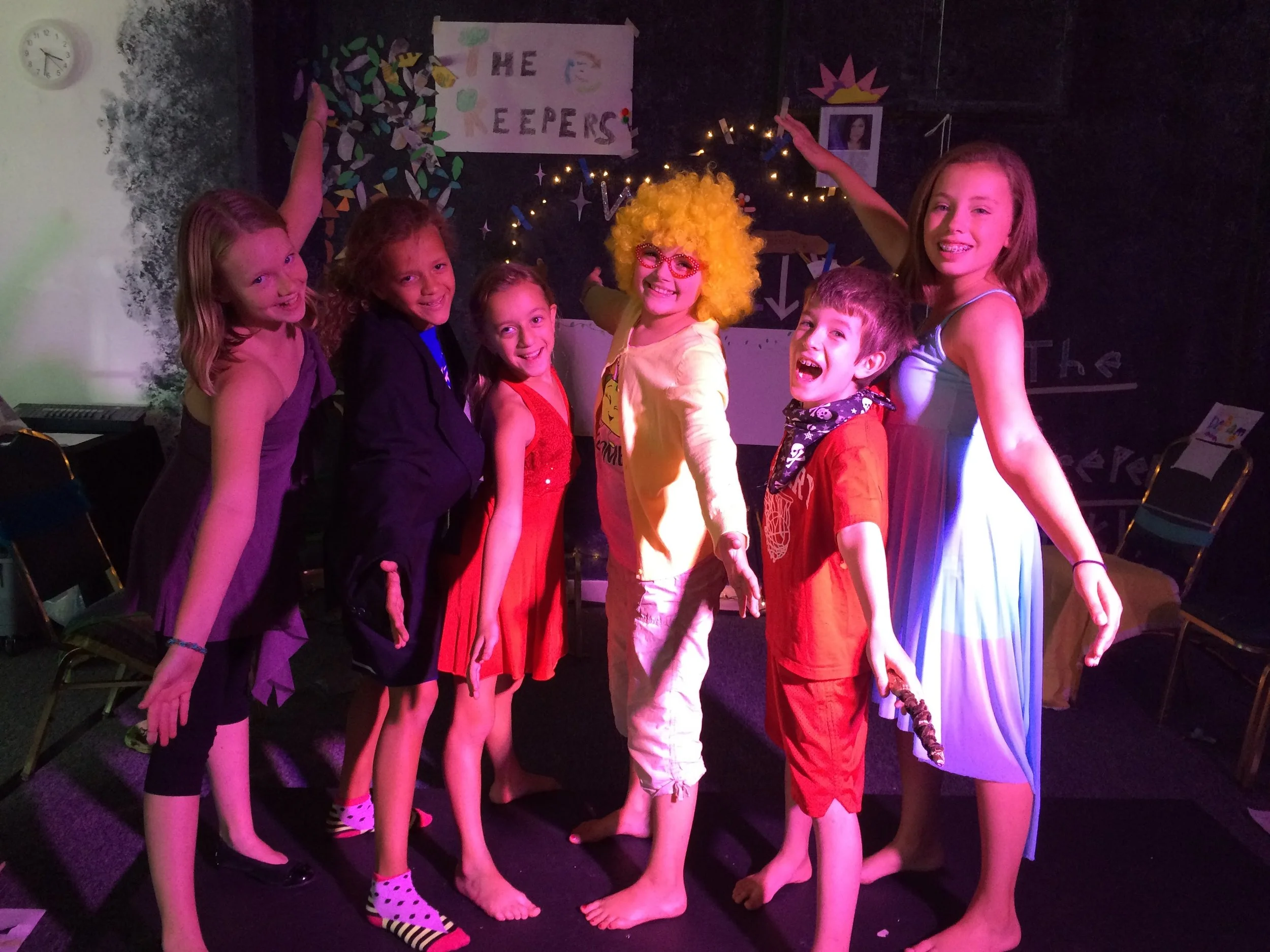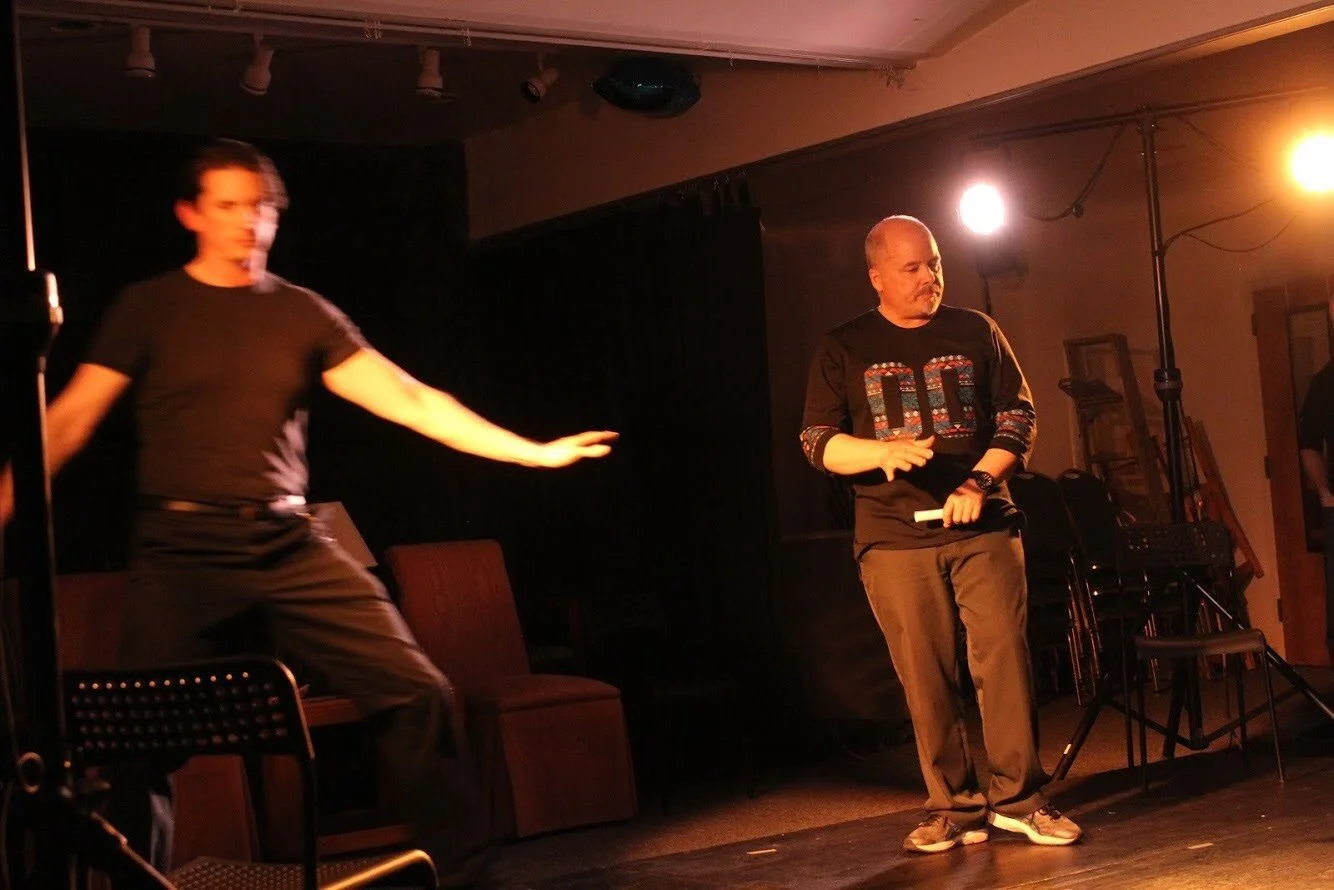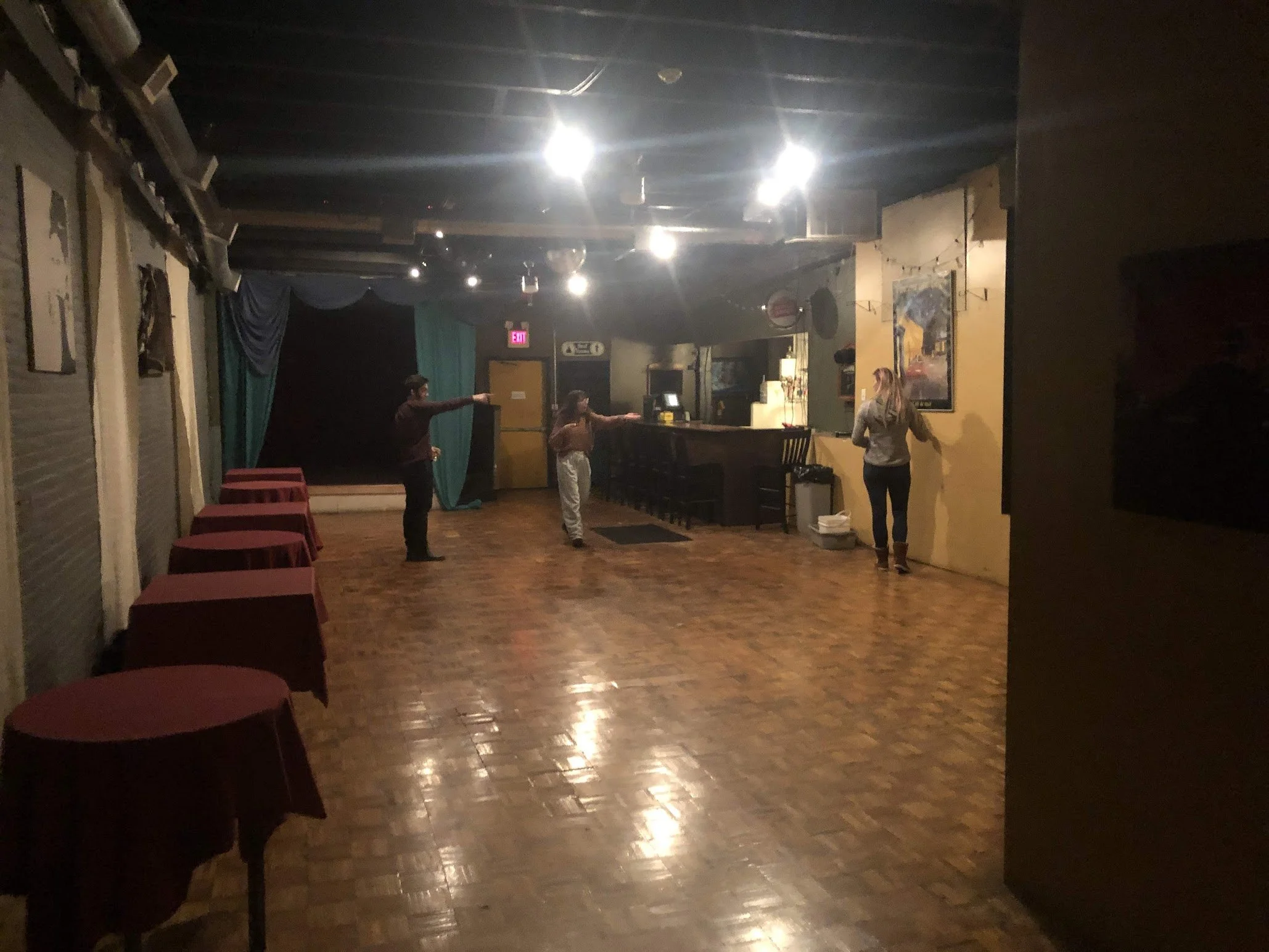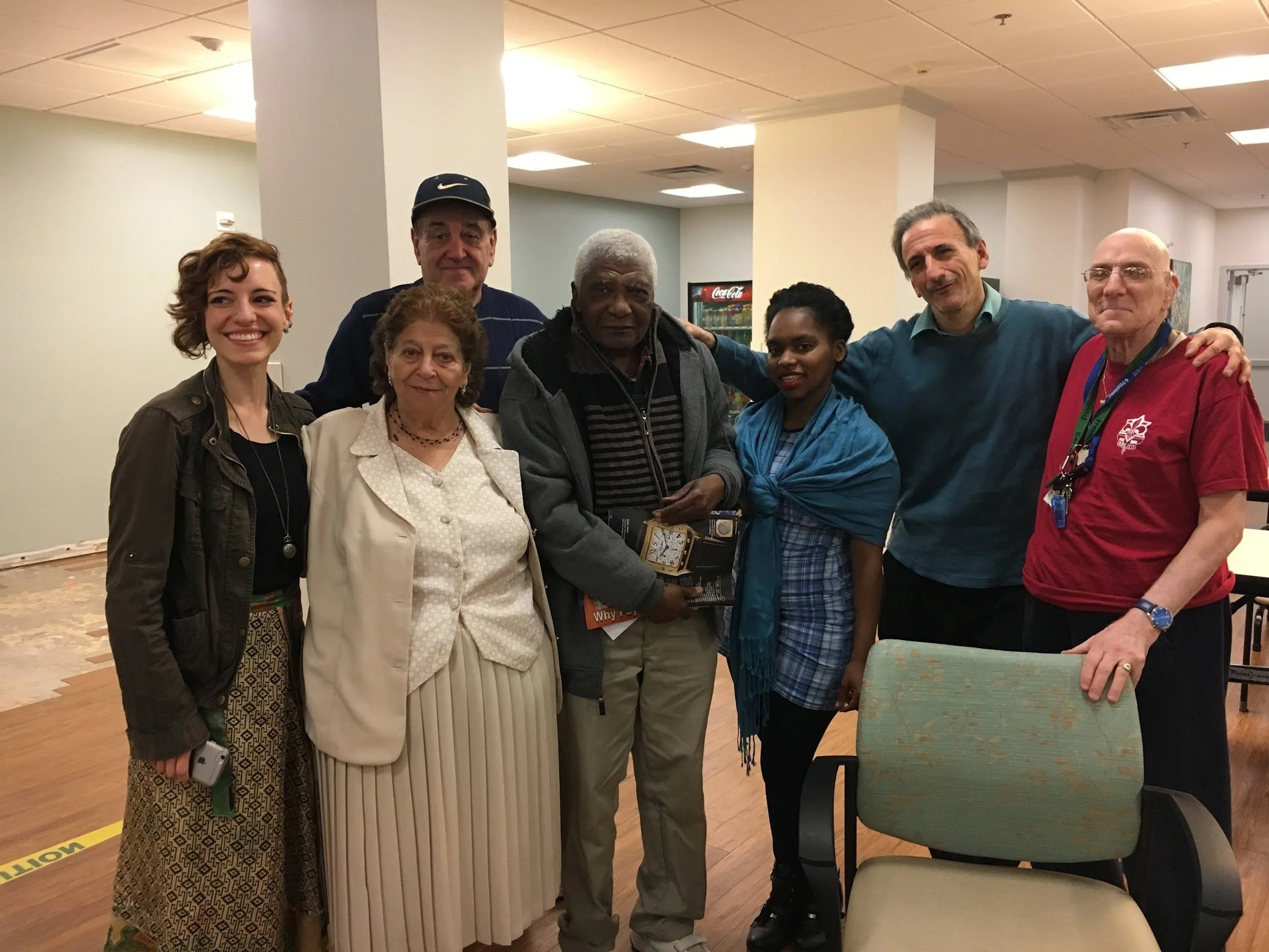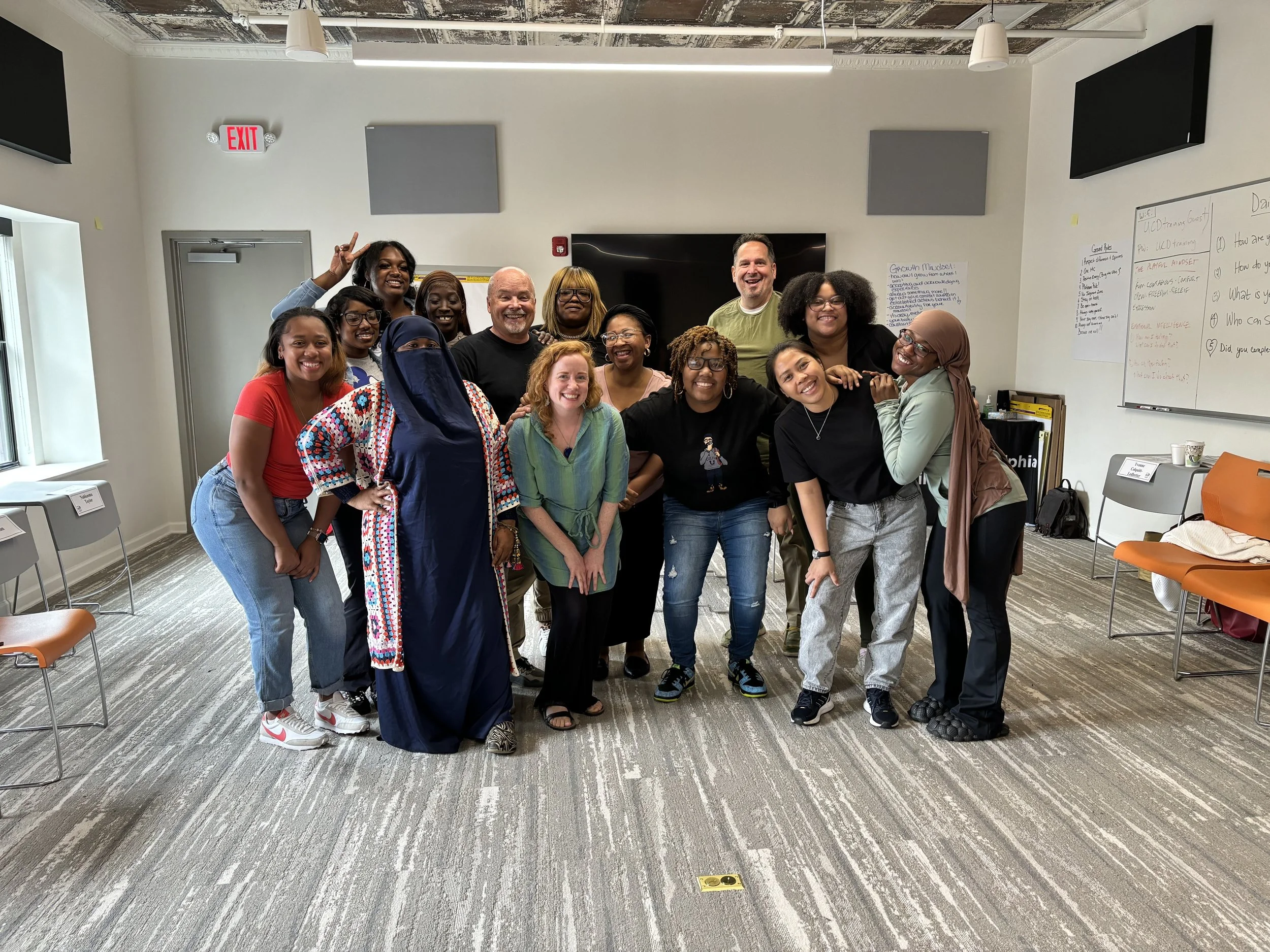Bright Invention, an elegy
At the center of Bright Invention were the many actor/improvisors who were in the ensemble. From 2014 - 2023, more than thirty Philadelphia actor/improvisors gave their time, talent and energy to Bright Invention. I am humbled and grateful.
Original ensemble (2013 - 2014): Randi Hickey, Michelle Pauls, Emily Gibson, Ed Swidey, Langston Darby, Katherine Perry, Kristine Norine, Benjamin Lloyd, Sarah Knittel, Francesca Piccione, Bob Stineman, Eva Farrell. Jerry Perna, Josh Totora; directed by Jennifer MacMIllan.
Jen in the middle with some of the original ensemble: Langston Darby, Bob Stineman (hidden), Emily Gibson, Katherine Perry and Francesca Piccione walking away, Jennifer MacMillan, Randi Hickey, Sarah Knittel, Jerry Perna.
A year ago last Sunday I euthanized the nonprofit I founded, Bright Invention (formally White Pines Productions.) And so, some memories of people, places, and events that mattered in the brief life of a little company dedicated to using improvisation to empower people and organizations to unlock their potential.
Jennifer MacMillan
Jennifer MacMillan. As I was conceiving of this organization based in improvisation, I had to acknowledge that I was a novice improvisor. There was no way I could lead a group in creating cutting-edge long form improvisation. Luckily for me at the time, Jennifer MacMillan was looking for her next chapter. I had seen her perform with the wonderful Philly long form group Tongue and Groove, directed by my original teacher Bobbi Block. I reached out and asked her how she would feel about directing a new long form company, the only requirement being that I had to be in it. And so in 2013, we held auditions, and in 2014 began performing in our new space in Elkins Park.
During her tenure with Bright Invention, she created and directed three brand-new formats including Click!, which used audience donated photographs to inspire our scenes; Your Mix Tape, which used audience suggested songs played in a random order to inspire our scenes; and Assemblage, which used stuff the audience found in their pockets, backpacks and purses and pinned to a mannequin on stage to inspire our scenes. Jen also created and directed our first Improvathon in 2015, which lasted 24 hours, each hour having a distinct theme or form attached to it. Yes, several of us improvised for 24 hours straight. And several of us left the ensemble for good directly afterwards.
Jen had to work with me in an awkward relationship. I was one of her actors in the ensemble, but I was also her boss as executive director. We did our best until it was time to move on. She was an inspiring artist to work with, she left an indelible mark on Bright Invention, and I learned a great deal from her.
Katherine Perry (and a camper.)
Katherine Perry and Dani Bryant. Katherine and Dani were my two Education Directors. Katherine helped me conceive and execute our first summer camp - camp White Pines - using our space in Elkins Park as home base. Both of them were responsible for extraordinary acts of creative genius by our young campers. We used High School Park across the street for lunch, recess breaks and special outdoor projects. We partnered with the co-op across the other street for bag lunches for the kids. We took field trips. Dani presided over our most successful camp program ever, our week-long Harry Potter themed program, which had kids flying in from other states to participate. Katherine and Dani were my primary creative partners when they worked for Bright Invention, and their support, council and creativity meant the world to me.
Dani Bryant
Isabel, Karen and me at the opening of the white Pines Place.
Karen Lecks and Isabel Cohen. Standing outside our newly opened venue in Elkins Park in the spring of 2014, I was approached by a woman with a teenager in tow. “This is so great!” she exclaimed. “A performing arts space right in our neighborhood! Will you be having classes for people with disabilities?” I stammered that, while that was a wonderful idea, I had no experience in that area and so wouldn’t feel good about offering classes to that community. She took my email address and told me she’d be in touch. A couple of weeks later, she asked if it would be okay if she paid to have us trained by Cindy Schneider, who had been teaching theatre to kids of all abilities for years, so that we might offer classes like that in future. What am I, stupid? I said yes! And because of her, our program using structured improvisation for people with disabilities was born: Acting Out!
Isabel, the teenager-in-tow that day, is her daughter and has been a member of our Acting Out group ever since. Various members of our ensemble became interested in working with this community (Jerry Perna, Eva Farrell, Kiersten Adams, Shea Sonsky) and are now working with this community in their own careers. The technique I developed which became Creative Corporate Training and later The Playground, was developed through my work with this group. I have gone on to present at national and international conferences on using structured improvisation with people with disabilities. The Acting Out parents and students were the most loyal and supportive community of the many communities we served. Some day, we will all play again.
Aimee Goldstein and Kelly McCaughan improvising in the round.
Improv in the round. Our stage design at the White Pines Place became a raised platform in the middle of the room, surrounded by chairs and sofas. Actors in our shows entered and exited from anywhere, and learned to use subtle, circular moves to open themselves up to audience around the room. At its best, it created a wonderful, intimate atmosphere of shared creative experience.
“Thriller'“ at the Masque
The 2017 White Pines Masque. Our one and only gala featured as a centerpiece a performance of Michael Jackson’s Thriller dance choreographed by the amazing Sutie Madison, who also worked with our students with disabilities. In the dance were board members, staff (like yours truly,) ensemble members, and students of all abilities. It was an amazing night, but unfortunately a fund-raising disaster which ended up losing us a lot of money. Was it worth it just for that dance? I think so . . .
Prof. Plum, The Rev. Green, Mrs. White, Miss Scarlett, Gen. Mustard, and Mrs. Peacock.
Room with a Clue. We had a few formats we could do site-specifically, and one of them used the board game Clue as its inspiration. Various ensemble members would be cast as Clue characters, and then improvise in character with the audience, who would walk from room to room meeting new characters and gathering clues. We did this a couple of times at the magnificent Glen Foerd Mansion and it was great fun.
Madame Saito’s Ballroom: stage on the left, bar on the right.
Madame Saito’s Ballroom. After we lost the White Pines Place, we became an itinerant improv ensemble, and performed in a variety of locations around town. Our favorite for sure was this strange, dilapidated but cool in a vintage-sort-of-way ballroom upstairs from a sushi restaurant near Headhouse Square in Philly. It had a bar, which worked when they had the staff to man it. It had a weird little postage-stamp stage stuck in corner that we used as a raised playing space, performing mostly on the floor in front of it. We had a cool hook for these shows: Improvasushi, a kind of dinner and a show invite which a bunch of audience members took us up on. It was especially fun when the waiters would come upstairs and bellow the name of their customer during a show! Alas, Madame Saito has also moved on, and the location is now a Mexican restaurant.
Bob and I performing The Sun and its Planets in the round at White Pines Place.
The Sun and its Planets. This was our signature form which I created with input from the ensemble. It was a variation on a Harold, with a single pair doing three consecutive acts, divided by other ensemble members forming pairs to do “dueling monologues” between acts one and two, and two and three. When it worked well, the characters from the dueling monologues were show-stoppers in themselves, and added wonderful information for the main pair to play with as they moved on.
The Left Behinds. I created several programs which we offered to various constituencies, and were fun and meaningful in their own right, but didn’t make it past the reorganization of 2018.
Ensemble members Leah, Kiersten and Jerry with some seniors.
John, Jerry, Katherine, Michelle, Daniel and Carol perform Story Toys.
The Senior Theater Project. This program served senior citizens in retirement homes, first by simply performing for them, then by taking stories they told during a workshop and turning those into structured improvisations performed by our ensemble. Later, a long-term relationship was established with Foulkeways in Gwennyd including classes for residents. Ensemble member Jerry Perna became the director of this program.
Story Toys. Our improv form for kids used toys and stuffed animals they brought to the show to inspire our actors to make characters out of them. Then we did a three-act long form with these toy-inspired characters. Later, we included “themes” to create an overall focus, like helping out, listening or sharing.
Storytize. We took various kinds of written texts, read portions of them out loud, and simultaneously improvised based on what was being read. This culminated in a brief relationship with the Israeli version of the podcast This American Life, called Real Life Israel. We performed episodes from the podcast for synagogues nearby, and once for the R.L.I. team themselves who were visiting a local Jewish community. We said, “We’re so honored to meet you in person!” And they said, “We’re so honored to meet you in person!”
Daniel, Jerry and Michelle perform Storytize.
The Wyncote Foundation. From the beginning, they believed in what I was trying to do: chart a new course for sustaining small, creative nonprofits. My goal was to invert the earned income/donated income ratio. Traditionally, nonprofits make 60 - 70% of their bottom line through donated income, and the rest from earned or “program” income - tickets sales, gift shop merch, classes and educational programs. My vision was that our consulting program, Creative Corporate Training, would grow to provide that 60 - 70% of our bottom line, and our dependence on donated income (from foundations and individuals) would be diminished. I predicted that we would then be a more appealing charity, being able to say that more than most that we could pay our own way.
My arrangement with Wyncote was that their general operating support would diminish year by year, so as to incentivize the growth of our corporate training program. For the uninitiated, general operating support is the manna from heaven of philanthropic gifts. It is money you can do whatever you want with (within the laws that govern nonprofit finance.) It is distinct from program support, which is money you can use only for a specific project. One of the reasons artistic nonprofits are dying off is that foundations have become reluctant to offer general operating support (which can be used for salaries, insurance, capital costs - you know, the essential expenses of any business, nonprofit or not.) Wyncote is exceptional. Foundations today are more like venture capital firms, and openly use terms like “return on investment” as a way to evaluate their grantees - an idea which was antithetical to philanthropy years ago.
None of what I have described above would have happened without the support of the Wyncote Foundation. Not only did they keep my dream alive for 12 years, but by providing me with a salary they kept my family afloat for 12 years.
Kaitlin, Bob, Leah and I get ready to offer a workshop to a very important client.
So what happened? Well, we came close. We delivered our first $20,000 corporate training workshop in the fall of 2019, and it was a hit. I was designing the second one for this client when the pandemic hit. It’s too simplistic to say the pandemic killed us - but like so many others I ask, what if? The buck stops with me. I was trying to do too much. I misunderstood the challenges of marketing a consulting practice. I was so fixated on trying to keep us going financially I lost focus on the creative work of the ensemble and the educational work with people of all abilities. My penchant for trying to do everything for everyone burned me and everyone else out. Even after the reorganization of 2018 the organization was stretched too thin.
Along the way there were fundraising failures. I already mentioned the Masque. My decision to close down Bright Invention was precipitated by another fundraising fiasco, Bright Nights, which was to have celebrated our work with people with disabilities in December of 2022. As the event approached and it became clear no one on the board was inviting anyone, they advised me to cancel the event, which I did. And with a soft thud the bird of death landed on our roof and I knew we were done. After conferring with some trusted confidants, in January 2023 I let everyone know that June 30, 2023 would be our last day.
Last year was a hard one for me for a lot of reasons. Closing down Bright Invention was a big part of it. At the time I felt it was my life’s work, and though we rarely had surplus cash, I had hoped I could grow it into something that would support my aging. Losing my “baby” and my salary was a huge blow. I went on unemployment, developed and facilitated workshops, was in a play, and spent a lot of time feeling sorry for myself.
But that was last year. Out of the ashes of Bright Invention sprang bxlloyd consulting, and I’m working with many of the same people on it. I’m performing in two different improv pieces (one recently appeared at three different improv festivals,) and have added several new workshop clients. This month I will be going with two assistants to offer a keynote presentation at a nonprofit leadership conference offered by the Blue Ridge Institute in Georgia. The future is bright.
Kate Black-Regan, Jack Presby and I with a cohort we just delivered a workshop to at the West Philadelphia Skills Initiative.
Farewell Bright Invention. I learned some hard lessons from you, I grew by leaps and bounds with you, you brought me life-long friends, and confirmed for me that improvisation is for everyone.
More soon . . .
A Bright Invention picture gallery . . .




